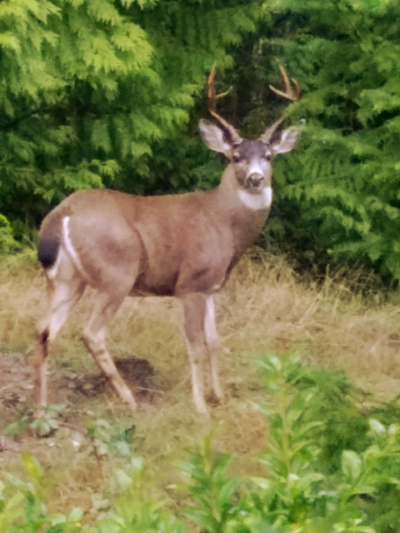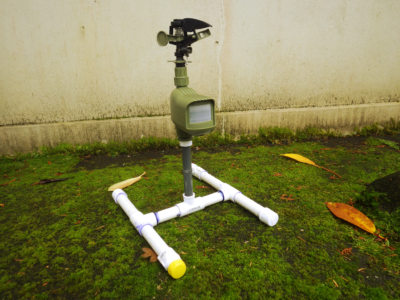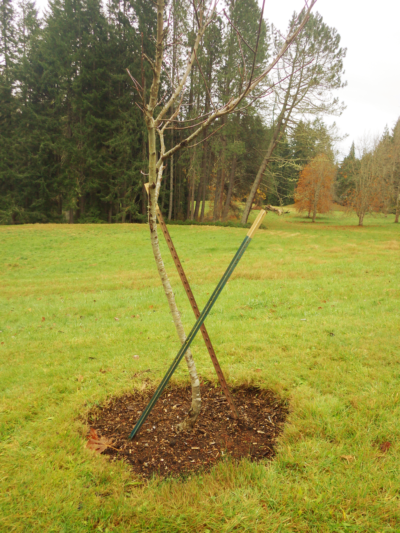Wildlife at Bloedel: Dealing with Deer
 At 140 acres of gardens, meadows and forest, Bloedel Reserve is a safe and attractive place for many species of wildlife, including deer. As many gardeners in the Puget Sound region will tell you, though we enjoy the sight of deer, unfortunately their visits often include them feeding on garden plants.
At 140 acres of gardens, meadows and forest, Bloedel Reserve is a safe and attractive place for many species of wildlife, including deer. As many gardeners in the Puget Sound region will tell you, though we enjoy the sight of deer, unfortunately their visits often include them feeding on garden plants.
We encounter two types of deer damage. Deer feeding on leaves and shoots is the most common and the easiest to spot. Another kind of damage may not be immediately apparent as deer damage — antler rubbing. It can be even more harmful to young trees than chewed foliage. What you will see are vertical sections of bark stripped away from the trunks of young, usually single-stemmed trees. Male deer rub their antlers against tree trunks to remove the “velvet” skin that covers the antlers when they regrow every year.
At Bloedel Reserve, there are steps we take that significantly reduce the degree and frequency of deer damage and they can be useful to home gardeners as well.
Repellents + Strategy
The primary method we use to combat deer feeding on foliage is to apply deer repellents. Both of the products we use are permitted for organic gardening. Using repellents successfully, however, means more than just spraying any repellent anywhere. Some strategy is necessary.
First, you need to pick a deer repellent that seems to actually work. The Reserve has had poor success with products like “coyote urine,” hair, and soap. The two repellents that have worked best for us have been products containing pepper extract combined with putrid egg whites. Though that sounds awful, it actually smells a lot like salad dressing. The important part is that the the deer don’t like it! They also don’t like products containing blood. The blood products smell terrible, so we use them sparingly but they work amazingly well.
The second part of the repellent strategy is to alternate between products. At Bloedel Reserve, the deer seem to acclimate if we use a single repellent continually, and eventually they start eating whatever we’ve been spraying. Alternating between the pepper and blood products each time we spray has proven more effective over the long haul.
The Right Timing & The Right Plants
Timing is important! We begin our deer repellent sprays in the spring before deer feeding begins. Young deer feed on many different kinds of plants in order to learn what they can eat. The theory is that applying deer repellent on the plants they are testing should teach them to avoid those plants in the future. This tactic, though not completely successful at Bloedel, seems to help.
Lastly, we pay close attention to what plants the deer actually eat. They won’t eat everything. We limit our sprays to plants we know they will eat as well as to valuable plants that they might eat. This approach can save both time and money, because deer repellents can be expensive. Be warned, however. On rare occasions, deer will munch on plant species you would never expect them to have eaten in a million years. This “oddball” feeding is more common in the winter when food is scarcer. As a general rule, deer prefer eating deciduous leaves over tougher evergreen leaves, but there are always exceptions.
 Surprise by Sprinklers
Surprise by Sprinklers
Besides using repellents, we employ a physical method to deter the deer. After the Reserve closes for the day, we set up sprinklers in front of the two dome-shaped Camperdown elms situated behind the Residence at the patio overlooking the bluff and Puget Sound. These two elms are unquestionably the deers’ most favorite food and we’ve found that spraying repellents doesn’t always deter feeding.
Our “deer repellent” sprinklers are not just run-of-the mill sprinklers. They have attached battery-powered motion sensors. Any time a deer (or you!) comes close, the sprinkler starts up suddenly and scares them away. As you can imagine, this startle-and-water-spray method is quite effective. We use these sprinklers for the Camperdown elms because they are very high-value specimens and much appreciated by the guests who visit the Reserve. Unfortunately because of cost and set-up time, we can’t put these sprinklers everywhere on the ground, which is why we rely mostly on other repellents.
 Post It
Post It
When it comes to preventing antler rubbing, repellents will not work. We’ve found that the best bet is to use some kind of barrier. In the past, Bloedel Reserve would erect fences around young plants, especially the more expensive ones. While this worked well to stop antler rubbing, the fences were very unsightly. Trunk wraps can also work, but they require continual upkeep, and they must be examined annually to ensure they are not strangling the young trees as they grow. Neither of these barrier methods is currently used at the Reserved.
In the early 2000s, Bloedel Reserve adopted the easier, cheaper, and much more aesthetic method of installing angled posts around trees to deter antler rubbing. Installing one or two posts at an angle in front of a tree trunk seems to be enough to stop a deer from rubbing its antlers in the up-down motion it uses to remove its antler velvet.
The posts don’t need to be fancy, just rigid. We use metal fence posts we purchase from a local hardware store. Usually these posts come already painted dark green and are suitable for immediate installation. (If you prefer a different color, a spray paint suitable for metals will work just fine. But be sure to spray the posts before you install them, to avoid getting paint on your garden plants.)
Striking a Balance
Bloedel Reserve is not only a botanical garden but also a wildlife preserve. Sometimes the two purposes conflict, so finding a balance is critical. Using these various techniques, we are able to provide peaceful meadows, forests, and gardens mostly devoid of chewed plants, which are welcoming and hospitable for our human visitors, as well as for the deer and other wildlife passing through.
SIGN UP FOR OUR ENEWSLETTER
Stay up to date on all of the events and activities taking place at Bloedel Reserve.

